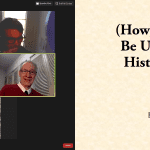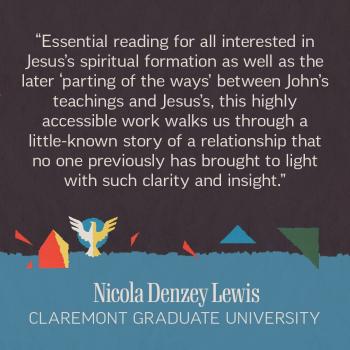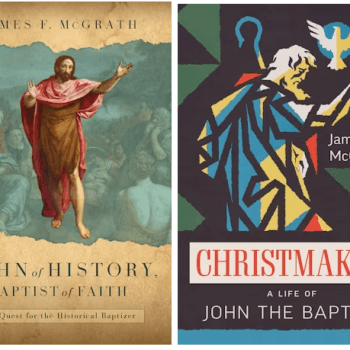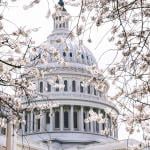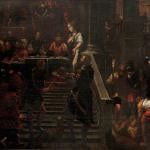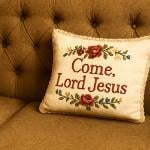Day Three of the Enoch Seminar conference on John the Baptist began once again with a recap of the previous day. (You can read my notes from the day in my blog post.) Gabriele Boccaccini had suggested that we focus our thoughts on the terminology of sectarianism. Right away the references we had been making to current events led me to think it would be useful to focus a conference on sectarianism ancient and modern. Then as now, people aligned themselves under labels, while others refused to be labeled in those ways. Among the latter, some were and are nonetheless aligned quite clearly with a particular stance, while others were and are eclectic and genuinely do not fit. Among the former, no group is entirely cohesive and uniform. Claiming that kings and leaders are in cahoots with diabolical forces is something found in the Book of Revelation and QAnon conspiracy theory. Zealots acted in a battle conceived in terms of good vs. evil that others shared a rhetorical expression of yet who did not kill anyone directly. There is probably much we can learn by a comparison across time and diverse contexts.
What does it mean to say that John’s movement was “sectarian” or reflected “common Judaism”? Boccaccini mentioned that it isn’t clear what “common Christianity” would mean if applied to our time, and so what is “common Judaism” in the first century? We can talk about what people share in common, but you won’t see “common Christianity” in a Catholic or a Pentecostal church, however much what is believed and done may not distinguish them from others. What you will find is “common Christianity” as it is expressed in a particular denomination and a specific community within that tradition. Yet as was emphasized yesterday, what “sects” do is always part of and a participant in the broader culture that they are in some specific way(s) trying to resist and differentiate themselves from.
Al Baumgarten mentioned the place of Morton Smith and Ed Sanders in shaping how academics think about “common Judaism,” mentioning the book Common Judaism that explored this subject. A “reformist sect” does not view other groups as totally lost, whereas an “introversionist group” has turned inward (using terminology from sociologist Bryan Wilson). Larry Schiffman shared the example of how something like Holocaust denial might put someone beyond the pale of membership in a conservative synagogue, even if all their other beliefs and observance aligned with conservative Judaism. It is thus not enough to ask whether certain core beliefs are held.
Esther Chazon pointed out that “common Judaism” is a term used by “lumpers” to which Baumgarten added that the terminology inevitably leaves some things out but so too does the terminology used by “splitters.” Chazon emphasized the need to be clear to whatever audience we are speaking to. We need the conceptual equivalent of the line at archaeological sites that distinguishes what is original from what is reconstruction. We need to speak differently depending on whether we are addressing students, giving a popular lecture, or at a conference conversing with other scholars. Chazon suggested that “common cultural background” is better than “common Judaism.”
Boccaccini said that people do not say they are a “common Jew” or a “common Christian.” I would say on the contrary that some do just that, for instance the “nondenominational Christians” whose shared characteristics are such that they are in practice a denomination. Schiffman said that he cannot envisage Jews dividing in war and violence towards one another the way that Catholics and Protestants did in Ireland. Different broad traditions may thus be very different in how sectarianism expresses itself. Paul Anderson mentioned in response that, in the first century, it seems that zealots did kill other Jews whom they considered collaborators.
Edmondo Lupieri emphasized the importance of discussing majority, minority, and fringe views. When the rabbis discuss whether wasp honey could be eaten, presumably they are addressing what someone else had claimed, but that does not mean that many held the view that is being responded to. Federico Adinolfi suggested that competition found in later times may not have existed from the outset, and this may be the case with respect to John and Jesus. Paul Anderson asked whether the Sadducees were a “sect” when they were also the establishment. He also pointed out that sects often view themselves as normative. Shayna Sheinfeld emphasized that identity is intersectional. We need Venn diagrams and not just labels.
Yonatan Adler started the next session by reminding us that texts from ancient times, written by literate people, often fail to accurately convey a sense of what ordinary typical people were doing. Nonetheless, texts are crucial, and one text that we have good reason to think tells us something about what was common among first-century Judaeans is the Torah. It indicates that purification can occur through washing. Ben Sira 34:30, Judith, and 4 Q Toharot A together indicate that people were interpreting this in a specific way, using baptizo in Greek or an equivalent in Hebrew or Aramaic, denoting immersion. Even though Josephus does not use that Greek word, Antiquities 3.263 refers to going down into water. The mikva’ot in the archaeological record also indicates this. The steps and waterproof plastering as well as the configuration not leaving much room to do anything other than immerse oneself all point to their use as ritual immersion pools. How do we interpret the fact that these are so widespread and seem to have been utilized by everyone. This was not just one specific sect or class, not just for use once a month.
Jonathan Lawrence followed, noting that tour guides in Israel have been heard commenting on Jewish purification immersion and Christian “baptism” when talking about the same type of mikveh! Lawrence thus had the idea to do comparative research on Christian and Jewish immersion pools in the Galilee. His dissertation took a different direction and so he is happy now to return to this topic. He noted the challenges with using texts from other times, including the Mishnah, to interpret archaeological evidence from our period. He also pointed out that we have significant numbers of references to washing which are metaphorical, which are relevant to our understanding of what was done literally and its significance, and yet which also represent something that may give a different impression than what people actually thought about the literal action. We must also do justice to the fact that the archaeological record is not completely uniform, and so must ask whether double pools, for instance, should or should not be categorized as mikva’ot. How do we distinguish different kinds of pools used by different groups for different purposes? Correlation with other archaeological data plays a role (e.g. presence or absence of pig bones), but mixed communities mean that we cannot extrapolate directly from one to the other without further discussion.
Ithamar Gruenwald spoke next on whether John baptized Jesus. He began with the fact, rarely discussed in this context although alluded to in Adler’s paper, that much ritual washing referred to in Leviticus and elsewhere referred to the washing of clothes. He highlighted the case of purification after being cured of leprosy as perhaps the only example of supervised purificatory washing, and the story of Naaman as the first example of ritual immersion specifically going down into the water of the Jordan. I have long wondered whether the story of Naaman had an influence on John the Baptist. Linguistically the name Jordan probably stems from a linguistic root denoting a river. Note that Mandaeans and Syriac Christians use “jordan” more widely than just in reference to the Jordan River. He noted the fact that Elijah came from Transjordan and the symbolic liminality of the Jordan River, connected with entry into the Promised Land proper.
Gabriele Boccaccini offered an Enochic perspective, relating John to apocalypticism in general and Enochic literature in particular. There were a range of views on the human and/or super-human origin of evil, and on whether Israel had been provided with a remedy that the rest of humankind lacked. John’s call to be baptized was aimed not at everyone but at sinners, those who needed to prepare for the judgment to come, not having done so already. It was a message not for all Israel but the lost sheep of Israel. That is why Christian literature spoke of Jesus dying for “many” rather than “all” and Jesus was recalled to have said he did not come to call the righteous who have no need of a doctor, but sinners. 1 Enoch 50-51 retells what was in Daniel, distinguishing Michael from the Chosen One (Son of Man). The language used in Enochic literature may help explain the puzzling reference to “the others” in Josephus’ account of John the Baptist.
Benjamin Snyder responded, seeking to bring additional clarity to the discussion of terminology and ritual, noting that some terms are broader or narrower than others, and so “immersion” may be a subset of “washing” just as “sautéing” is a subdivision of “cooking.” So too “immersion” and/or “washing” may be crucial to “purification” and yet still only one part of the process rather than strictly synonymous. When and where we find immersion pools is also relevant. That they are not only in and near Jerusalem and continue to appear after 70 CE tells us something about whether they were focused on temple or even the city of Jerusalem.
If Boccaccini is correct that the aim was for sinners to be baptized and not to baptize every human being, then one might have to say that it was not initially an initiatory act. That’s an interesting idea, that perhaps one could become a Christian but, being already righteous, not be baptized. Joel Marcus noted in response that the Synoptic Gospels suggest everyone came to John, and he only rebuffed those he considered unrepentant.
Edmondo Lupieri asked whether John’s activity focused in Transjordan was symbolic in connection with the Jordan as a boundary to the land. He also drew attention to the fact that the Mandaeans use “jordan” to denote any flowing river water that is suitable for baptism. Carsten Claussen noted the lack of immersion pools in the Jewish Diaspora. Adinolfi agreed with Boccaccini that the Baptist did not think the entire nation was corrupt and in need of repentance and baptism down to every last individual. On the other hand, he thinks the “others” in Josephus were not sinners but takes it as an attempt to distance the Baptist from some radicals associated with him who took up his message and practice. Thomas Kazen emphasized the need to do justice to the fact that the widespread use of mikva’ot was an innovation. He also noted how this connects with questions about the symbolic significance of John’s baptism. If it was associated with the priestly washing when entering sacred space, for interest, then all priests were expected to wash and not only if they were “sinners.” Boccaccini pointed out that, in light of the fact that everyone was engaging in ritual immersions, that cannot be what John was calling for and practicing, since he stood out as “immerser” in his time.
Benjamin Snyder started the next session focusing on the way antecedents are appealed to (purity immersion, proselyte baptism, etc.). “Baptism” is broad and the very act of positing something as a purported antecedent often determines how we then understand John’s rite. Using “baptism” as though it were a technical term thus causes problems. We should refer to “immersion” and then discuss what John’s immersion meant. The term “baptizo” does appear to have a causative sense, but did he compel people to immerse themselves, or did he himself “dunk” them? Snyder suggests that John was addressing everyone while expecting those who needed forgiveness to respond. We need to get away from the assumption that immersion signified initiation. He ended with the question of whether Jesus’ immersion was “embarrassing.”
Larry Schiffman spoke next on John’s baptism in relation to the practice at Qumran, emphasizing the differences and the problems that are involved in viewing John through the lens of Qumran. He also said that the Christian understanding and depiction of John cannot serve as our starting point given what we know about their ideological motivation. He thus considers the linkage with the Holy Spirit as secondary.
Thomas Kazen discussed the Hasmonean innovations in immersion practice as a means of reinforcing Jewish identity. He posed directly the question of what purification was from and for. Many envisaged purification from something with water. There was a practice of washing to ritually purify, and also use of washing away sin as a metaphor. Kazen suggests that the varied ideas and ways of speaking were combined inputs into John’s thinking and practice. In his view, John’s baptism was not a substitute for sacrifice.
Vered Noam spoke about John and the “morning immersers.” She was seeking to take some of the materials Joel Marcus highlights in an appendix to his book, with additional light from rabbinic sources. The exchange of complaints in the Mishnah has the dawn immersers blame the Pharisees for pronouncing the name of God without having first immersed. The Pharisees accuse the dawn immersers of speaking the name from a body full of impurity. The Tosefta has a different version, in which the dawn immersers accuse the Pharisees about impurity. Noam disagreed with Marcus’ suggestion that this might be more original, as it appears to represent an inadvertent omission due to similar words. Noam argues that the Pharisees are being ironic, emphasizing that the human body contains impurities within it and from which it thus cannot be purified. This group appears to be the same group referred to as “daily baptists” in some Christian sources such as the Pseudo-Clementines. Marcus considers it unlikely that John was one of these “dawn immersers” and Noam agrees. See b.Berachot 22a which also mentions them, although the later Rabbinic sources were using a known name of an earlier group in a derogatory way, not referring to the actual group itself. Noam thinks the Pseudo-Clementines do likewise, associating John in an insulting way with a despised sect of an earlier era.
Jonathan Klawans argued that John’s baptism was intended to be an eschatological atoning rite. He began with the murder of the prophet named Zechariah as per a story in 2 Chronicles. The story had a profound influence on Josephus, and Klawans argued that Josephus patterned what he wrote about John on that story. He did this in the context of denying that John was introducing an innovation. We should trust the Gospels over Josephus. The use of a water rite for atonement may reflect ideas such as those found in Ezekiel 36, and needn’t mean that he was focused on ritual purity and defilement. In view of Klawans’s mention of Ezekiel 36 as a possible influence, I wonder whether Ezekiel’s vision of a new Jerusalem and temple from which water flowed might not also have played a role.
In the discussion time Yonatan Adler asked what characterized the “morning immersers” if everyone was immersing in this time. Vered Noam replied that others may have immersed in the evening. They may also have made it their practice to immerse every morning regardless of whether anything such as a nocturnal emission required it. Larry Schiffman pointed out that we may have multiple motives for things that we do. He also pointed out that daily immersers and morning immersers may not necessarily be the same thing. He also mentioned that Hasidic Jews immerse every morning since it makes all days the same, keeping experiences like nocturnal immersion private. He questioned, however, whether this has anything to do with John. Joan Taylor agreed with many of his points and emphasized how difficult it is to draw lines of continuity across centuries. We need to be very careful. Taylor also emphasized that purification was not understood by ancient people as a metaphor, but rather they genuinely believed that something changed as a result of ritual washing. Boccaccini ended the session noting that, after three days of speaking nonstop about John the Baptist, we still have so much to speak about and in such a lively manner!
In the next session Lester Grabbe started his presentation about Herod Agrippa with a survey about the family of Herod, mentioning that the tendency of some to refer to Herod Philip and Herod Agrippa should stop given that not all of the family descended from Herod used the name of their ancestor in this way, in the era when his descendents were tetrarchs and ethnarchs but not “kings.” He notes that Tiberias became a Rabbinic center with no hint that there was an issue due to it having been built on tombs, as was alleged by Josephus. See Jensen’s work on Herod Antipas in Galilee. The dance of Herodias is unlikely to be historical. Salome had long since been married to Philip the Tetrarch and Antipas’ kingdom ultimately belonged to Rome and so was not his to divide or share. Some of the details covered, related to Agrippa’s tensions and conflict with the ruler of Arabia and his pursuit of the title “king” get a mention in my forthcoming book What Jesus Learned from Women, and I think these details that most New Testament scholars don’t pay much attention to are actually important background to the lives and actions of some of the people we are most interested in.
Nathan Shedd also spoke about Antipas, starting with Commodus and ideas of manliness in the Roman world, and what the beheading of someone (or of an animal) indicated. Antipas’ manipulation by women constitutes a negative characterization against that background. The construct of an emasculated Antipas does not itself determine whether there is a historical basis for the story. He closed by recalling Raphael Rodriguez’s points from the first day of the conference, asking what in the inherited tradition might have called for or justified this portrait.
Rivka Nir presented next on John the Baptist as a martyr. Josephus provides evidence that, in the second temple period, the biblical prohibition against “uncovering the nakedness of one’s brother’s wife” was extended to cases of divorce, which is not clearly implied in the scriptural text itself. In Judaism, martyrs were figures like those in the books of the Maccabees who were threatened with death if they did not disobey the Law, e.g. eating pork. John, on the other hand, is depicted like a Christian martyr who is executed for his testimony. This is the same point Nir makes in her book about John the Baptist, and since the stories about Israel’s prophets tell of individuals who challenged rulers and were imprisoned and executed (especially as their stories were told in postbiblical works such as “Lives of the Prophets”), Nir is clearly assuming rather than proving her point, namely that John is depicted as a Christian rather than Jewish martyr. See my review of Nir’s book which the Enoch Seminar published.
Shayna Sheinfeld presented on John as prophet in first-century Judaism, noting how he is viewed as an “outlier” in that context. This reflects Christian reception of him rather than what we know about his teaching and his sociocultural context. Even figures who did not engage in or advocate violence were active in a context in which political tensions gave much speech the potential to be considered incitement to insurrection even when this was not explicit. The Samaritan, Theudas, the Egyptian, Jesus ben Ananias, Jonathan the weaver, as well as Jesus and John, all deserve to be compared and related to one another. John is not an outlier and he should not be assumed to be exceptional.
We next moved to responses, starting with Gregory Doudna. Doudna thinks Josephus mistakenly attached a tradition about the death of Hyrcanus II to the wrong Herod and thus John the Baptist. This in turn influenced the Synoptics. Morten Hørning Jensen noted that nothing and everything was “religion” in the ancient world in a way that few post-Enlightenment scholars can imagine. He is working on a book about the “imposters” that Sheinfeld’s paper at the conference also focused on. Making a modern analogy, Jensen said that someone cannot march around the Capitol seven times and claim the act is “not political.” He asked whether the panelists have any suggestions on how if at all to distinguish between “politics” and “religion.” Joel Marcus asked whether Grabbe’s point about Salome necessarily negates the historicity of a germ of the story, criticism of Antipas’ marriage. Criticizing a ruler’s marriage was obviously a political attack. Responding to Sheinfeld, Marcus said that it was expected for those stamping out a revolutionary to also deal with their followers. This was not done in the case of Jesus and some of the others she mentioned. Is this significant? Boccaccini asked why Josephus takes a negative view of “imposters” yet seems more sympathetic to others, including John the Baptist and Jesus ben Ananias. Was it just the extent of which they were perceived as anti-Roman? Nathan Shedd has been working on a book that discusses evidence that some thought decapitation prevented a person being resurrected or restored to life, which may be relevant to the discussion of Antipas asking whether Jesus could be John. Larry Schiffman and John Kampen raised the question of the order in which our conference and conversations have unfolded, since things have been coming up about context and method on this third day that might have been more useful if they preceded other discussions. I think that the subject is so complex and multifaceted that there is no one point that can serve as the default or obvious entry point. Steve Mason pointed out the problems with taking Josephus’ statements which either esteem or denigrate an individual and assuming that we can set aside his aims and framing and yet assume that there was an individual about whom we can say things in relation to our own aims. We can call “religious” or “prophetic” whatever we want, but our ancient sources and their perspectives do not necessarily align. Sheinfeld concluded our discussion by emphasizing that she uses “prophetic” as an etic category and not in the same way as ancient authors like Josephus did. Boccaccini quickly suggested that tomorrow we turn at the outset to the question of John’s messianism.
Another conference attendee has a work out that is worth drawing attention to and which got a mention in the chat on Zoom: Tamás Visi, “The Chronology of John the Baptist and the Crucifixion of Jesus of Nazareth: A New Approach,” JSHJ 18 (2020): 3–34.
One observation I made is that there does not appear to be a “history of the mikveh” that indicates things like where the oldest ones are found and whether we can trace a spread of them to elsewhere in the archaeological record. If some of the earliest are found in Jerusalem, for instance, and then they begin to appear later at further distances away, this might tell us something about their original significance and what they then came to mean when used more broadly, and how this innovation was promoted. Is there a book or article that at least has the raw archaeological data needed to explore this further? Yonatan Adler and Ronny Reich have provided some of this, mostly in works published in Hebrew. What is available in English may be found on Adler’s Academia site and Reich’s articles on the Jerusalem Perspectives site.
There are many different ways one might correlate the evidence from texts and archaeology. The references to John baptizing at the Jordan and also in places where “there was much water” such as Aenon near Salim suggests that John was not a promoter of mikveh use. He may have accepted the legitimacy of that for ritual purification, but what he called for was (as the Mandaeans continue to emphasize) immersion in “living water” i.e. the flowing water of a river. Whether he was nonetheless influenced by the promulgation of ritual immersion in the century before John’s time is nonetheless worth asking.
For those interested in the Mandaeans, Charles Haberl just shared that he has a new article out on the Mandaean calendar. You can find a pre-publication version shared on his Rutgers web page.


